The ASTI Data in Focus series provides additional background data in support of the 2010 Country Note on Guinea (asti.cgiar.org/pdf/Guinea-Note.pdf) prepared by the Agricultural Science and Technology Indicators (ASTI) initiative and the Guinean Agricultural Research Institute (IRAG). Based on data collected by ASTI and IRAG, these two outputs review major investment and capacity trends in Guinea's public agricultural research and development (R&D) since 1991, providing important updates on agricultural R&D trends prepared by ASTI and IRAG in 2003–04.
C. Human Resources
This section provides detailed quantitative information on full-time equivalent (FTE) agricultural research and support staff trends, including qualifications, gender distribution, and support-staff-per-researcher ratios. Complementary sections present detailed data on long-term trends (Section A), financial resources (Section B) and research allocation (Section D). Other supporting information provides macroeconomic trends, a list of agencies included in the study, data sources and estimation procedures, and ASTI's methodology.
Table C1–Total researcher levels across various agencies, 2008
In 2008, Guinea's Agricultural Research Institute (IRAG) employed 152 full-time equivalent (FTE) researchers, accounting for two-thirds of the country total human resource capacity in agricultural R&D. Two of the other government agencies, Institut Pasteur de Guinée (IPG) and the National Fisheries Science Center of Boussoura (CNSHB) employed more than 10 FTE researchers, whereas the remaining six government and all higher education agencies employed 5 FTEs or fewer.
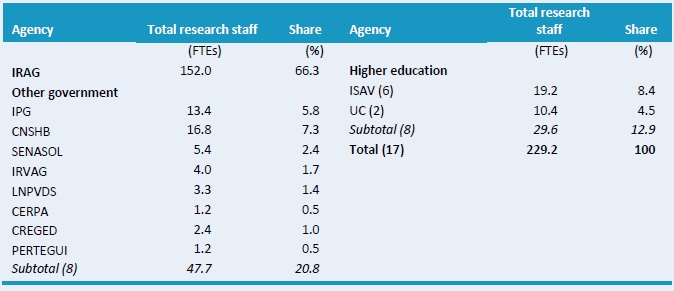
Sources: Calculated by authors from IFPRI–IRAG 2009 and Stads and Béavogui 2003.
Notes: Figures in parentheses indicate the number of agencies in each category. Data include French and North Korean expatriate research staff employed at IRAG. For more information on coverage and estimation procedures, see the Guinea country page on ASTI's website at asti.cgiar.org/guinea/datacoverage.
Figure C1–Full-time equivalent researcher trends at IRAG by degree, 1991–2008
The number of researchers at IRAG increased from 130 FTEs in 1991 to 143 FTEs in 2008. IRAG's agricultural research capacity also became more highly qualified. In 1991, 16 percent of IRAG's researchers held MSc or PhD degrees, compared with 27 percent in 2008.
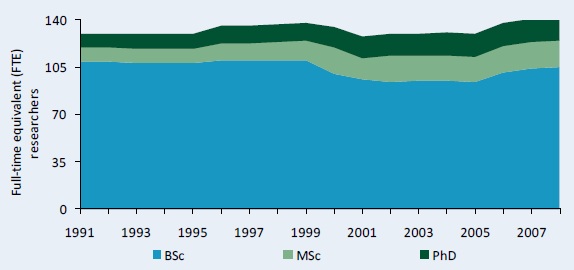
Sources: Calculated by authors from IFPRI–IRAG 2009 and Stads and Béavogui 2003.
Note: For more information on coverage and estimation procedures, see asti.cgiar.org/guinea/datacoverage.
Figure C2–Full-time equivalent researcher trends at other government agencies by degree, 2001–08
The number of researchers employed at the other government agencies remained constant during the 2001–08 period. Average degree levels at these agencies also remained stable.
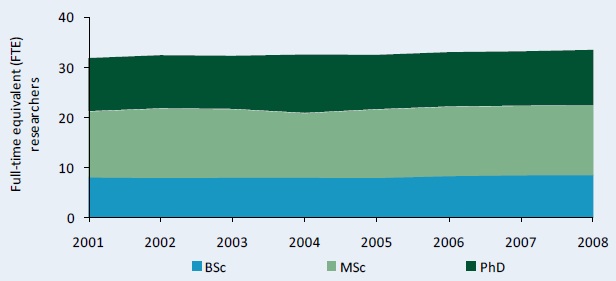
Source: Calculated by authors from IFPRI–IRAG 2009.
Notes: IPG was excluded from this figure because data were not available. For more information on coverage and estimation procedures, see asti.cgiar.org/guinea/datacoverage.
Figure C3–Full-time equivalent researcher trends at higher education agencies by degree, 1995–2008
The number of agricultural researchers employed at the higher education agencies increased from 21 FTEs in 1995 to 30 FTEs in 2008. Despite this increase in total capacity, the share of PhD-qualified researchers decreased from 34 to 29 percent, but the share of MSc-qualified researchers more than doubled to 31 percent in 2008.
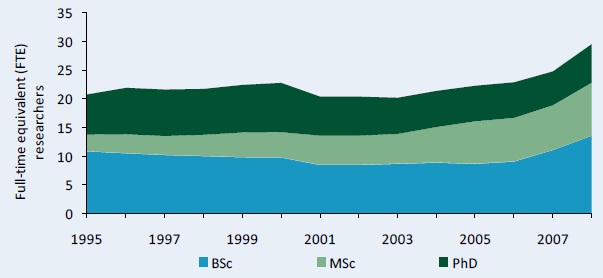
Source: Calculated by authors from IFPRI–IRAG 2009 and Stads and Béavogui 2003.
Note: For a complete list of the agencies included in our sample, see asti.cgiar.org/guinea/agencies.
Figure C4–Distribution of researcher qualifications across agencies, 2008
The Research Center for Waste Management (CREGED) and the Study Project on Indigenous Technologies (PERTEGUI) employed the highest share of PhD-qualified researchers in 2008 (50 percent). Notably, the other government agencies (combined) employed a higher share of PhD-qualified researchers than the higher education agencies (30 versus 23 percent), which sharply contrasts with the situation in other African countries. On average, 18 percent of the agricultural FTE researchers in Guinea held PhD qualifications, while 21 percent were MSc qualified, and 62 percent were BSc qualified.
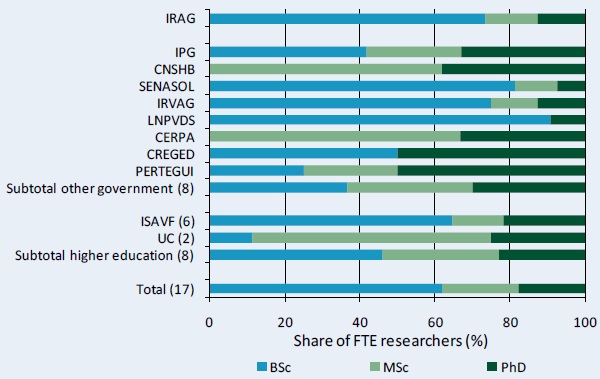
Source: Calculated by authors from IFPRI–IRAG 2009.
Note: Figures in parentheses indicate the number of agencies in each category.
Figure C5–Share of female researchers by degree and institutional category, 2008
Consistent with other countries in this region, female researchers are severely underrepresented in Guinean agricultural R&D. Based on available data for 2008, women accounted for 5 percent of total agricultural R&D capacity. IRAG had the lowest share of female researchers across institutional categories (2 percent). The share of female researchers at thee other government agencies (combined) averaged 13 percent. Across degree levels, the highest share of female researchers was found among MSc-qualified researchers (13 percent). Notably, women accounted for only 1 percent of PhD-qualified researchers.
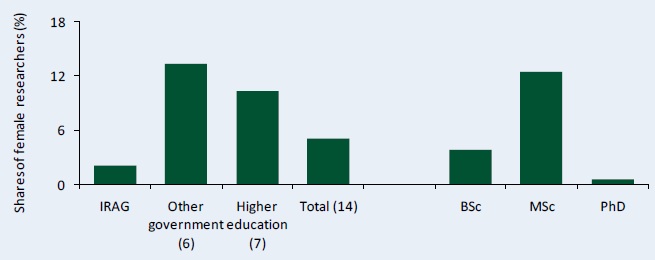
Source: Calculated by authors from IFPRI–IRAG 2009.
Notes: Figures in parentheses indicate the number of agencies in each category. DNE, IPG, and PERTEGUI were excluded from the other government agencies, and ISAV-GR from the higher education agencies, because data were not available. For a complete list of the agencies included in the sample, see asti.cgiar.org/guinea/agencies.
Copyright (C) 2011 International Food Policy Research Institute (IFPRI) and Guinean Agricultural Research Institute (IRAG). Sections of this Data in Focus issue may be reproduced without the express permission of, but with acknowledgement to IFPRI and IRAG. This series is an output of the ASTI initiative and has not been peer reviewed. Any opinions stated herein are those of ASTI and do not necessarily reflect the policies and opinions of IFPRI or IRAG.
